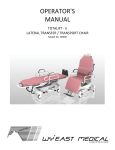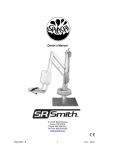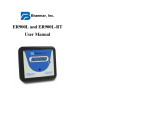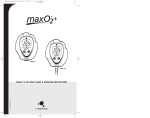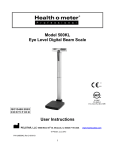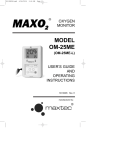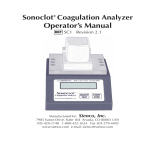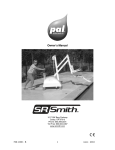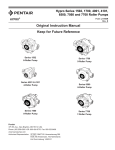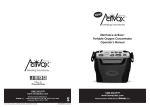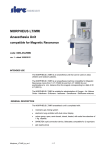Download Operating Manual for the Handi+ Oxygen Analyzer
Transcript
Handi+ ® OPERATING MANUAL & INSTRUCTIONS FOR USE R218P12 R218M12 Rev. D Maxtec, Inc. 6526 South Cottonwood Street Salt Lake City, Utah 84107 USA TEL (800) 748.5355 FAX (801) 270.5590 www.maxtecinc.com Authorized Representative: EC REP QNET BV Hommerterweg 286 6436 AM Amstenrade The Netherlands CLASSIFICATION Classification: . . . . . . . . . . . . . . . . . . . . . . . . . . . . . . . . . . . . . . . . . . . . Class II medical device. Protection against electric shock: . . . . . . . . . . . . . . . . . . . . . . . . Internally powered equipment. Protection against water: . . . . . . . . . . . . . . . . . . . . . . . . . . . . . . . . . . . . . . . . . . . . . . . . . . . IPX1 Mode of Operation: . . . . . . . . . . . . . . . . . . . . . . . . . . . . . . . . . . . . . . . . . . . . . . . . . . Continuous Sterilization: . . . . . . . . . . . . . . . . . . . . . . . . . . . . . . . . . . . . . . . . . . . . . . . . . . . . . See section 6.0 Flammable anesthetic mixture: . . . . . . . . . . . . . . . . . . . . . Not suitable for use in presence of a flammable anesthetic mixture Product Disposal Instructions: The sensor, batteries, and circuit board are not suitable for regular trash disposal. Return sensor to Maxtec for proper disposal or dispose according to local guidelines. Follow local guidelines for disposal of other components. WARRANTY Maxtec®, Inc., warrants the Handi®+ to be free from defects of workmanship or materials for a period of two-(2) years from the date of shipment from Maxtec®, under normal operating conditions and provided that the Handi®+ is properly operated and maintained in accordance with Maxtec®'s operating instructions. Should Handi®+ fail prematurely, the replacement Handi®+ is warranted for the remainder of the original analyzer warranty period. Based on Maxtec®'s product evaluation, Maxtec®'s sole obligation under the foregoing warranty is limited to making replacements, repairs or issuing credit for equipment found to be defective. This warranty extends only to the buyer purchasing the equipment directly from Maxtec®, Inc. or through Maxtec®'s designated distributors and/or agents as new equipment. Routine maintenance items are excluded from this warranty. Maxtec®, Inc. shall not be liable to the purchaser or other persons for incidental or consequential damages or equipment that has been subject to abuse, misuse, misapplication, alteration, negligence or accident. THESE WARRANTIES ARE EXCLUSIVE AND IN LIEU OF ALL OTHER WARRANTIES, EXPRESSED OR IMPLIED, INCLUDING WARRANTY OF MERCHANTABILITY AND FITNESS FOR A PARTICULAR PURPOSE. 866.4.Maxtec www.maxtecinc.com I WARNINGS ! Indicates a potentially hazardous situation, if not avoided, could result in death or serious injury. » Before use, all individuals who will be using this product must become thoroughly familiar with the information contained in this Operation Manual. Strict adherence to the operating instructions is necessary for safe and effective product performance. This product will perform only as designed and only if installed and operated in accordance with the manufacturer's operating instructions. » Although the sensor of this device has been tested with various anesthesia gases including nitrous oxide, Halothane, Isoflurane, Enflurane, Sevoflurane and Desflurane and found to have acceptably low interference, the device in entirety (including electronics) is not suitable for use in the presence of a flammable anesthetic mixture with air or with oxygen or nitrous oxide. Only the threaded sensor face, flow diverter, and “T” adapter may be allowed to contact such a gas mixture. » This device does not contain automatic barometric pressure compensation. »D o not use near any type of flame or flammable/explosive substances, vapors or atmosphere. » Not for use in an MRI environment. » Improper use of this device can cause inaccurate oxygen readings which can lead to improper treatment, hypoxia or hyperoxia. Follow the procedures outlined in this user manual. CAUTION: Indicates a potentially hazardous situation, if not avoided, could result in minor or moderate injury and property damage. » The Maxtec MAX-250 oxygen sensor is a sealed device containing a weak acid electrolyte, lead (Pb), and lead acetate. Lead and lead acetate are hazardous waste constituents and should be disposed of properly, or returned to Maxtec for proper disposal or recovery. »T he Handi®+ is not intended for steam, ethylene oxide or radiation sterilization. Do not autoclave or expose the sensor to high temperatures. Do not immerse the Handi®+ oxygen analyzer in any cleaning solution. » The flow diverter provided with the Handi®+ is for use with flowing gases only. Do not use the diverter when performing static sampling (e.g., in incubators, oxygen tents, oxygen hoods). » Do not attempt any repairs or procedures, which are not described in this Operation Manual. Maxtec cannot warrant this product from damage resulting from misuse, unauthorized repair or improper maintenance of this product. »T he Federal (USA) law restricts this device to sale by or on the order of a physician. » There are no internal user-serviceable parts. » Never install the sensor in a location that will expose the sensor to patient’s exhaled breath or secretions. II 866.4.Maxtec www.maxtecinc.com TABLE OF CONTENTS Classification . . . . . . . . . . . . . . . . . . . . . . . . . . . . . . . . . . . . . . . . . . . . . . . . . . . . . . . I Warranty . . . . . . . . . . . . . . . . . . . . . . . . . . . . . . . . . . . . . . . . . . . . . . . . . . . . . . . . . . I Warnings . . . . . . . . . . . . . . . . . . . . . . . . . . . . . . . . . . . . . . . . . . . . . . . . . . . . . . . . . II 1.0 INTRODUCTION . . . . . . . . . . . . . . . . . . . . . . . . . . . . . . . . . . . . . . . . . . . . . . . . 1 1.1 Component Identification . . . . . . . . . . . . . . . . . . . . . . . . . . . . . . . . . . . . . . . . 1 1.2 Symbol Guide . . . . . . . . . . . . . . . . . . . . . . . . . . . . . . . . . . . . . . . . . . . . . . . . . 2 1.3 Description . . . . . . . . . . . . . . . . . . . . . . . . . . . . . . . . . . . . . . . . . . . . . . . . . . . 2 2.0 CALIBRATING THE HANDI+ . . . . . . . . . . . . . . . . . . . . . . . . . . . . . . . . . . . . . . . 2 2.1 Before you begin . . . . . . . . . . . . . . . . . . . . . . . . . . . . . . . . . . . . . . . . . . . . . . 2 2.2 Calibrating the HANDI®+ Oxygen Analyzer . . . . . . . . . . . . . . . . . . . . . . . . . . 2 2.3 In-Line Calibration (Configuration A) . . . . . . . . . . . . . . . . . . . . . . . . . . . . . . . 3 2.4 Direct Flow Calibration (Configuration B) . . . . . . . . . . . . . . . . . . . . . . . . . . . . 3 3.0 OPERATING THE HANDI®+ . . . . . . . . . . . . . . . . . . . . . . . . . . . . . . . . . . . . . . . 4 4.0 FACTORS INFLUENCING ACCURATE READINGS . . . . . . . . . . . . . . . . . . . . 5 4.1 Elevation Changes . . . . . . . . . . . . . . . . . . . . . . . . . . . . . . . . . . . . . . . . . . . . . 5 4.2 Temperature Effects . . . . . . . . . . . . . . . . . . . . . . . . . . . . . . . . . . . . . . . . . . . . 5 4.3 Pressure Effect . . . . . . . . . . . . . . . . . . . . . . . . . . . . . . . . . . . . . . . . . . . . . . . . 5 4.4 Humidity Effect . . . . . . . . . . . . . . . . . . . . . . . . . . . . . . . . . . . . . . . . . . . . . . . . 6 5.0 CALIBRATION ERRORS AND ERROR CODES . . . . . . . . . . . . . . . . . . . . . . . . 6 6.0 CLEANING AND MAINTENANCE . . . . . . . . . . . . . . . . . . . . . . . . . . . . . . . . . . . 7 7.0 SPECIFICATIONS . . . . . . . . . . . . . . . . . . . . . . . . . . . . . . . . . . . . . . . . . . . . . . . 7 7.1 Analyzer Specifications . . . . . . . . . . . . . . . . . . . . . . . . . . . . . . . . . . . . . . . . . 7 7.2 Effect of Interferent Gases and Vapors . . . . . . . . . . . . . . . . . . . . . . . . . . . . . 8 8.0 HANDI+ SPARE PARTS AND ACCESSORIES . . . . . . . . . . . . . . . . . . . . . . . . . 8 8.1 Standard Replacement Parts and Accessories . . . . . . . . . . . . . . . . . . . . . . . 8 9.0 FREQUENTLY ASKED QUESTIONS . . . . . . . . . . . . . . . . . . . . . . . . . . . . . . . . 9 866.4.Maxtec www.maxtecinc.com III 1.0 INTRODUCTION 1.1 Component Identification LCD Display: A 3-digit display provides a direct readout of oxygen concentration in the range of 0 - 100%. The display is blank when the Handi®+ enters its Sleep (power off) mode. The Handi®+ will automatically enter the Sleep mode after approximately 1.3 minutes from the last time the ON button was pressed. ON/OFF Button: Use this button to turn the Handi®+ on and off. When the Handi®+ is in the Sleep (power off) mode, the LCD display is blank. The analyzer turns off after 1.3 minutes if no buttons are pressed. Calibration Button: Press the calibration (CAL) button to adjust the calibration value to reflect the known oxygen concentration. To simplify operation, the Handi®+ Analyzer automatically determines the calibration gas being used as room air (20.9%) or high grade (100%). Flow Diverter: The flow diverter is designed to fit industry standard 15 mm I.D. "T" adapters. Over Range Indicator: The appearance of a decimal point after the first digit means that the Handi®+ is reading in excess of 99.9%. Example: . . . . . . . . . . . . . . . . . . . . . . . . . . . . . . . . . . . . . . . . . . . . . 0.0.0 = 100% . . . . . . . . . . . . . . . . . . . . . . . . . . . . . . . . . . . . . . . . . . . . . . . . . . . . . 0.0.1 = 101% . . . . . . . . . . . . . . . . . . . . . . . . . . . . . . . . . . . . . . . . . . . . . . . . . . . . . 0.0.2 = 102% . . . . . . . . . . . (If the display reads > 0.0.3 the Handi®+ should be re-calibrated.) 866.4.Maxtec www.maxtecinc.com 1 1.2 Symbol Guide The following symbols and safety labels are found on the the Handi®+: ! Attention, consult accompanying documents On/off Button Meets ETL standards Calibration Button Do not throw away. Follow local guidelines for disposal. SN Serial Number LOT Lot code/Batch code Manufacturer Rxonly For use by prescription only Contains acid 1.3 Description REF Catalog Number Pb Contains lead Authorized Representative in the EC REP European Community The Maxtec® Handi®+ oxygen analyzer is designed to monitor oxygen concentration in the patient-breathing environment. It is one of a full line of oxygen analyzers by Maxtec®. The Handi®+ oxygen analyzer utilizes the Maxtec® MAX-250 oxygen sensor and is engineered for fast response, maximum reliability and stable performance. The Handi®+ is designed primarily for spot-checking of oxygen levels delivered by medical oxygen delivery equipment and respiratory care systems. Its lightweight, compact size, extended battery life, and "auto off" feature makes this oxygen analyzer ideal for portable oxygen analysis by qualified heath care professionals. 2.0 CALIBRATING THE Handi®+ 2.1 Before You Begin A protective film covering the threaded sensor face must be removed and the sensor allowed to “breath” for at least 30 minutes. Next, the Handi®+ Oxygen Analyzer should be calibrated. Thereafter, Maxtec® recommends calibration on a weekly basis. However, more frequent calibration will not adversely affect product performance. 2.2 Calibrating the Handi®+ Oxygen Analyzer Calibration of the instrument is necessary if the temperature of the gas stream changes by more than 3 degrees Celsius. Changes in elevation result in calibration error of approximately 1% of reading per 250 feet. In general, calibration of the instrument should be performed when the geographic elevation at which the product is being used changes by more than 500 feet. 2 866.4.Maxtec www.maxtecinc.com In addition, calibration is recommended if the user is unclear when the last calibration procedure was performed or if the measurement value displayed is in question. Calibrate the Handi®+ to an oxygen source, which has a traceable certificate and/or USP certification, of either 20.9% oxygen, as found in room air, or 100% oxygen. It is recommended that the oxygen source be documented at a pressure and flow similar to your clinical application. Note: Before beginning calibration the Handi®+ must be in thermal equilibrium. You may also need to be aware of other factors, which affect device calibration values. For more information, refer to "Factors Influencing Calibration and Performance" on page 5 of this manual. Note: We recommend use of medical grade oxygen at 100% when calibrating the Handi®+. 2.3 In Line Calibration (Configuration A) 1. Put the Handi®+ in an upright position such that you can read the product label. 2. Connect a sample supply hose to a standard "T" piece. The Maxtec® "T" is precision-tapered to insure a tight connection with O-rings of the MAX-250 oxygen sensor diverter. 3. Insert the Handi®+ in the center position of the "T" piece. 4. Attach an open-ended reservoir to the end of the "T" piece. Then start the calibration flow of oxygen at 1-10 liters per minute. Note: Six to 10 inches of corrugated tubing works well as a reservoir. Note: A calibration oxygen flow to the Handi®+ of 2 liters per minute is recommended to minimize the possibility of obtaining a "false" calibration value. 5. Allow the oxygen to saturate the sensor. Although a stable value is usually observed within 30 seconds, allow at least 2 minutes to ensure that the sensor is completely saturated with the calibration gas. 6. If the Handi®+ is not already turned on, do so now by pressing the analyzer ON button. 7. Press the “CAL” button on the Handi®+. The calibration gas value on the analyzer display should read 20.9 or 100 depending on the gas stream used. 2.4 Direct Flow Calibration (Configuration B) 1. Attach the Barbed Adapter to the Handi®+. 2. Connect the clear sampling tube to the Barbed Adapter. 3. Attach the other end of the clear sampling tube to a source of oxygen with a known oxygen concentration value and initiate flow of the calibration gas to the unit at a rate of 1-10 liters per minute (2 liters per minute is recommended). 4. Allow the oxygen to saturate the sensor. Although a stable value is usually observed within 30 seconds, allow at least 2 minutes to ensure 866.4.Maxtec www.maxtecinc.com 3 complete saturation of the sensor with the calibration gas. 5. If the Handi®+ is not already turned on, do so now by pressing the analyzer “ON” button. 6. Press the “CAL” button on the Handi®+. The calibration gas value on the analyzer display should read 20.9 or 100 depending on the gas stream used. Configuration A Configuration B Barbed Adapter Flow Diverter Clear Tubing "T" Adaptor (To gas) 3.0 OPERATING THE HANDI®+ To Check the Oxygen Concentration of a Sample Gas: 1. Maintain the Handi®+ in an upright position such that you can read the product label. 2. Place the Handi®+ in the sample gas stream. IMPORTANT: »W hen using a standard "T" adapter, make sure that the sensor is mounted in the adapter with the flow diverter pointing down. »M ake sure that there is a tight fit between the flow diverter and the "T" adapter. 3. Start the flow of the sample gas to the sensor. 4. Allow the oxygen sensor to remain in the flow of the sample gas until stable. 5. If the Handi®+ is not already turned on, do so now by pressing the analyzer ON button. 6. Read the value displayed on the LCD. Note: If the Handi®+ is used to measure the oxygen concentration with equipment using a heated or humidified gas stream, it is recommended that the Handi®+ be placed upstream of the heater and/or humidifier. For more information, refer to "Factors Influencing Calibration and Performance" on page 5 of this manual. 4 866.4.Maxtec www.maxtecinc.com For hospital and home care a new calibration is required when »T he measured O2 percentage in 100% O2 is below 97.0% O2. »T he measured O2 percentage in 100% O2 is above 103.0% O2. For ID testing (or optimum accuracy), a new calibration is required when »T he measured O2 percentage in 100% O2 is below 99.0% O2. »T he measured O2 percentage in 100% O2 is above 101.0% O2. 4.0 FACTORS INFLUENCING ACCURATE READINGS 4.1 Elevation Changes »C hanges in elevation result in a reading error of approximately 1% of reading per 250 feet. »A change in altitude greater than 500 ft will require sensor recalibration. »T his device does not automatically compensate for changes in barometric pressure or altitude. If the device is moved to a location of a different altitude, it must be recalibrated before use (see section 2.2). 4.2 Temperature Effects The Handi®+ will hold calibration and read correctly within ±3% when in thermal equilibrium within the operating temperature range. The device must be thermally stable when calibrated and allowed to thermally stabilize after experiencing temperature changes before readings are accurate. For these reasons, the following is recommended: » When used in a breathing circuit, place the sensor upstream of the heater. »F or best results, perform the calibration procedure at a temperature close to the temperature where analysis will occur. » Allow adequate time for the sensor to equilibrate to a new ambient temperature. 4.3 Pressure Effect Readings from the Handi®+ are proportional to the partial pressure of oxygen. The partial pressure is equal to the concentration times the absolute pressure. Thus the readings are proportional to the concentration if the pressure is held constant. Flow rate of sample gas can affect pressure at the sensor in that back pressure at the sensing point may change. For these reasons, the following is recommended: » Calibrate the Handi®+ at the same pressure as the sample gas. » If sample gases flow through tubing, use the same apparatus and flow rates when calibrating as when measuring. » The Handi®+ oxygen sensor has been validated at pressures up to 2 atmospheres absolute. Calibration or operation above this pressure is beyond the intended use. 866.4.Maxtec www.maxtecinc.com 5 4.4 Humidity Effect Humidity has no effect on the performance of the Handi®+ other than diluting the gas, as long as there is no condensation. Depending on the humidity, the gas may be diluted by as much as 4%, which proportionally reduces the oxygen concentration. The device responds to the actual oxygen concentration rather than the dry concentration. Environments where condensation may occur are to be avoided since condensate may obstruct passage of gas to the sensing surface, resulting in erroneous readings and slower response time. For this reason, the following is recommended: » Avoid usage in environments greater than 95% relative humidity. » When used in a breathing circuit, place the sensor upstream of the humidifier. 5.0 CALIBRATION ERRORS AND ERROR CODES The Handi®+ analyzers have a self test feature built into the software to detect faulty calibrations, oxygen sensor failures, and low operating voltage. These are listed below, and include possible actions to take, if an error code occurs. E02: No sensor attached Open unit and disconnect and reconnect sensor. Unit should perform an auto calibration and should read 20.9%. If not, contact Customer Service for possible sensor replacement. E03: No valid calibration data available Make sure unit has reached thermal equilibrium. Press and hold the Calibration Button for three seconds to manually force a new calibration. E04: Battery below minimum operating voltage Contact Customer Service for possible battery replacement CAL Err St: O2 Sensor reading not stable Wait for displayed oxygen reading to stabilize when calibrating the device at 100% oxygen. Wait for unit to reach thermal equilibrium (Please note that this can take up to one half hour, if the device is stored in temperatures outside the specified operating temperature range). CAL Err lo: Sensor voltage too low Press and hold the Calibration Button for three seconds to manually force a new calibration. If unit repeats this error more than three times, contact Customer Service for possible sensor replacement. CAL Err hi: Sensor voltage too high Press and hold the Calibration Button for three seconds to manually force a new calibration. If unit repeats this error more than three times, contact Customer Service for possible sensor replacement. 6 866.4.Maxtec www.maxtecinc.com CAL Err Bat: Battery voltage too low to recalibrate Contact Customer Service for possible battery replacement 6.0 CLEANING AND MAINTENANCE When cleaning or disinfecting the Handi®+, take appropriate care to prevent any solution from entering the analyzer. »T he Handi®+ surface may be cleaned using a cloth moistened with 65% isopropyl alcohol/water solution or germicidal wipe. »T he Handi®+ may be disinfected using standard topical disinfectants. »T he Handi®+ is not intended for steam, ethylene oxide or radiation sterilization. »S tore the Handi®+ in a temperature similar to its ambient environment of daily use. 7.0 SPECIFICATIONS 7.1 Analyzer Specifications Measurement Range: . . . . . . . . . . . . . . . . . . . . . . . . . . . . 0.0 - 99.9% oxygen (gas) Resolution/Display: . . . . . . . . . . . . . . . . . . . . . . . . . . . . . . . . . . . . . . . . . . . . . . 0.1% The three digit LCD indicates values between 0.0 - 99.9% oxygen Over range indicated by one decimal point on display located after the first digit Accuracy and Linearity: . . . . . . . 1% of full scale at constant temperature, R.H. and pressure when calibrated at full scale Total Accuracy: . . . . . . . . . . . ±3% actual oxygen level over full operating temp range Response Time: . . . . . . . . . . . . . . . . . < 15 seconds for 90% step change. (at 25˚C) Warm-up Time: None required Operating Temperature: . . . . . . . . . . . . . . . . . . . . . . . . . . 15˚C - 40˚C (59˚F - 104˚F) Storage Temperature: . . . . . . . . . . . . . . . . . . . . . . . . . . . . -15˚C - 50˚C (5˚F - 122˚F) Atmospheric Pressure: . . . . . . . . . . . . . . . . . . . . . . . . . . . . . . . . . . .800-1013 mBars Humidity: . . . . . . . . . . . . . . . . . . . . . . . . . . . . . . . . . . . . . . . 0-95%(non-condensing) Environmental: . . . . . . . . . . . . . . . . General purpose housing equivalent to NEMA 1. The Handi®+ is not waterproof. Warranty: . . . . . . . . . . . . . . . . . . . . . . Twelve months in normal operating conditions Power Requirements: . . . . . . . . . . . . . . . . . . . . . . . . . . . . Powered by one internal, non-replaceable Lithium battery, CR2450. Power on push button automatically shuts off after 80 seconds time-out. Electronics rated general purpose; not for use in hazardous areas or for use with flammable gases. Sensor Type: . . . . . . . . . . . . . . . . . . . . . . . Maxtec MAX-250 series galvanic fuel cell Weight: . . . . . . . . . . . . . . . . . . . . . . . . . . . . . . . . . . . . . . . . . . . . . . Approx. 60 grams 866.4.Maxtec www.maxtecinc.com 7 7.2 Effect of Interferent Gases and Vapors Gas Nitrous Oxide Halothane Isoflurance Enflurane Sevoflurane Desflurane Carbon Dioxide Helium Volume % Dry 75% 5% 5% 5% 6% 15% 10% 70% Interference in O2 < 2% < 2% < 2% < 2% < 2% < 2% < 2% < 2% 8.0 HANDI®+ SPARE PARTS AND ACCESSORIES 8.1 Standard Replacement Parts and Accessories 8 Part Number Item R218M12 R218M12-001 RP16P02 R110P10 R207P17 R100P92-002 R213P92 RP16P10 R218P09 Operation Manual, Handi®+ Operation Manual, Handi®+ International "T" Adapter Flow Diverter Fitting Barbed Adapter Clear Tubing Lanyard MaxConnect “T” Adapter Handi®+ Cover 866.4.Maxtec www.maxtecinc.com 9.0 Frequently Asked Questions 1. After I calibrate to 20.9%, the display changes as much as ± 1%. This is within the normal Handi®+ operating tolerance of ± 1% when temperature and pressure are constant. 2. I have calibrated to 99.9% but when I check my oxygen delivery equipment, the Handi®+ reads ".0.4" or greater (Over Range Indicator). It is recommended that you conduct the calibration procedure again to get another reading. The most likely cause is that the Handi®+ has received a "false" calibration value. Make sure that the calibration gas is connected to the Handi®+ at 2 liters per minute for a minimum of 2 minutes prior to proceeding with calibration. This 2-minute equilibration time is necessary to insure that the sensor is completely saturated with the calibration gas. 3. I have found the reading to drift greater than ± 3% from a know source value. What is the possible cause? The sensor may be at or near its useful life. Replace your Handi®+. Sensor life is dependent on the oxygen concentration exposure. For example, a sensor which is used to check flow meters once a week for 8 hours will outlast one which is used to analyze oxygen blender performance 24 hours per day, 5 days a week 866.4.Maxtec www.maxtecinc.com 9















